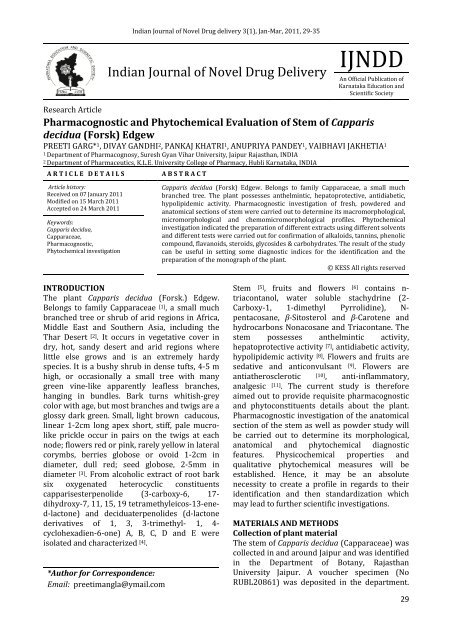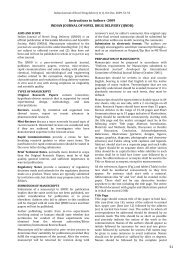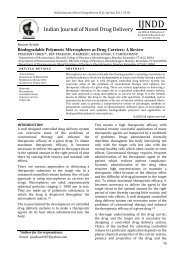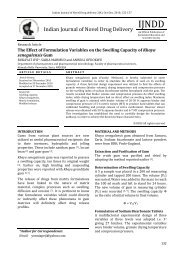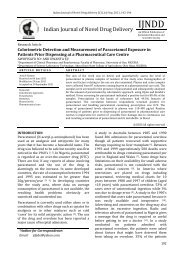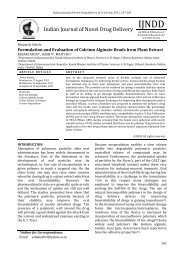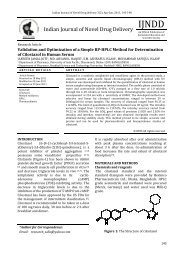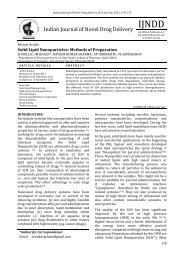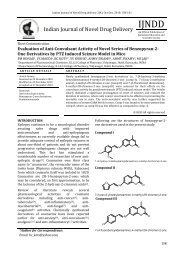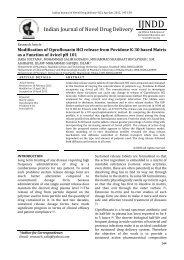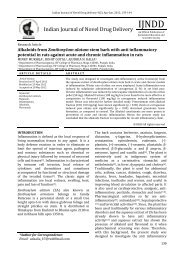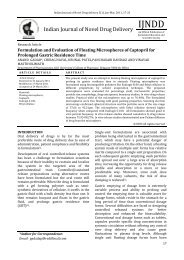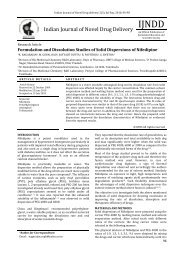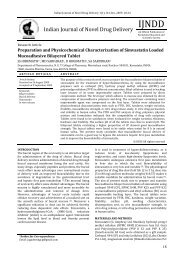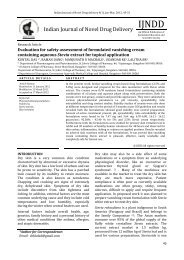(Forsk) Edgew - Indian Journal of Novel Drug Delivery
(Forsk) Edgew - Indian Journal of Novel Drug Delivery
(Forsk) Edgew - Indian Journal of Novel Drug Delivery
You also want an ePaper? Increase the reach of your titles
YUMPU automatically turns print PDFs into web optimized ePapers that Google loves.
<strong>Indian</strong> <strong>Journal</strong> <strong>of</strong> <strong>Novel</strong> <strong>Drug</strong> delivery 3(1), Jan-Mar, 2011, 29-35<br />
<strong>Indian</strong> <strong>Journal</strong> <strong>of</strong> <strong>Novel</strong> <strong>Drug</strong> <strong>Delivery</strong><br />
IJNDD<br />
An Official Publication <strong>of</strong><br />
Karnataka Education and<br />
Scientific Society<br />
Research Article<br />
Pharmacognostic and Phytochemical Evaluation <strong>of</strong> Stem <strong>of</strong> Capparis<br />
decidua (<strong>Forsk</strong>) <strong>Edgew</strong><br />
PREETI GARG* 1 , DIVAY GANDHI 2 , PANKAJ KHATRI 1 , ANUPRIYA PANDEY 1 , VAIBHAVI JAKHETIA 1<br />
1 Department <strong>of</strong> Pharmacognosy, Suresh Gyan Vihar University, Jaipur Rajasthan, INDIA<br />
2 Department <strong>of</strong> Pharmaceutics, K.L.E. University College <strong>of</strong> Pharmacy, Hubli Karnataka, INDIA<br />
A R T I C L E D E T A I L S<br />
Article history:<br />
Received on 07 January 2011<br />
Modified on 15 March 2011<br />
Accepted on 24 March 2011<br />
Keywords:<br />
Capparis decidua,<br />
Capparaceae,<br />
Pharmacognostic,<br />
Phytochemical investigation<br />
A B S T R A C T<br />
Capparis decidua (<strong>Forsk</strong>) <strong>Edgew</strong>. Belongs to family Capparaceae, a small much<br />
branched tree. The plant possesses anthelmintic, hepatoprotective, antidiabetic,<br />
hypolipidemic activity. Pharmacognostic investigation <strong>of</strong> fresh, powdered and<br />
anatomical sections <strong>of</strong> stem were carried out to determine its macromorphological,<br />
micromorphological and chemomicromorphological pr<strong>of</strong>iles. Phytochemical<br />
investigation indicated the preparation <strong>of</strong> different extracts using different solvents<br />
and different tests were carried out for confirmation <strong>of</strong> alkaloids, tannins, phenolic<br />
compound, flavanoids, steroids, glycosides & carbohydrates. The result <strong>of</strong> the study<br />
can be useful in setting some diagnostic indices for the identification and the<br />
preparation <strong>of</strong> the monograph <strong>of</strong> the plant.<br />
© KESS All rights reserved<br />
INTRODUCTION<br />
The plant Capparis decidua (<strong>Forsk</strong>.) <strong>Edgew</strong>.<br />
Belongs to family Capparaceae [1] , a small much<br />
branched tree or shrub <strong>of</strong> arid regions in Africa,<br />
Middle East and Southern Asia, including the<br />
Thar Desert [2] . It occurs in vegetative cover in<br />
dry, hot, sandy desert and arid regions where<br />
little else grows and is an extremely hardy<br />
species. It is a bushy shrub in dense tufts, 4-5 m<br />
high, or occasionally a small tree with many<br />
green vine-like apparently leafless branches,<br />
hanging in bundles. Bark turns whitish-grey<br />
color with age, but most branches and twigs are a<br />
glossy dark green. Small, light brown caducous,<br />
linear 1-2cm long apex short, stiff, pale mucrolike<br />
prickle occur in pairs on the twigs at each<br />
node; flowers red or pink, rarely yellow in lateral<br />
corymbs, berries globose or ovoid 1-2cm in<br />
diameter, dull red; seed globose, 2-5mm in<br />
diameter [3] . From alcoholic extract <strong>of</strong> root bark<br />
six oxygenated heterocyclic constituents<br />
capparisesterpenolide (3-carboxy-6, 17-<br />
dihydroxy-7, 11, 15, 19 tetramethyleicos-13-ened-lactone)<br />
and deciduaterpenolides (d-lactone<br />
derivatives <strong>of</strong> 1, 3, 3-trimethyl- 1, 4-<br />
cyclohexadien-6-one) A, B, C, D and E were<br />
isolated and characterized [4] .<br />
*Author for Correspondence:<br />
Email: preetimangla@ymail.com<br />
Stem [5], fruits and flowers [6] contains n-<br />
triacontanol, water soluble stachydrine (2-<br />
Carboxy-1, 1-dimethyl Pyrrolidine), N-<br />
pentacosane, β-Sitosterol and β-Carotene and<br />
hydrocarbons Nonacosane and Triacontane. The<br />
stem possesses anthelmintic activity,<br />
hepatoprotective activity [7] , antidiabetic activity,<br />
hypolipidemic activity [8] . Flowers and fruits are<br />
sedative and anticonvulsant [9]. Flowers are<br />
antiatherosclerotic [10], anti-inflammatory,<br />
analgesic [11] . The current study is therefore<br />
aimed out to provide requisite pharmacognostic<br />
and phytoconstituents details about the plant.<br />
Pharmacognostic investigation <strong>of</strong> the anatomical<br />
section <strong>of</strong> the stem as well as powder study will<br />
be carried out to determine its morphological,<br />
anatomical and phytochemical diagnostic<br />
features. Physicochemical properties and<br />
qualitative phytochemical measures will be<br />
established. Hence, it may be an absolute<br />
necessity to create a pr<strong>of</strong>ile in regards to their<br />
identification and then standardization which<br />
may lead to further scientific investigations.<br />
MATERIALS AND METHODS<br />
Collection <strong>of</strong> plant material<br />
The stem <strong>of</strong> Capparis decidua (Capparaceae) was<br />
collected in and around Jaipur and was identified<br />
in the Department <strong>of</strong> Botany, Rajasthan<br />
University Jaipur. A voucher specimen (No<br />
RUBL20861) was deposited in the department.<br />
29
Preeti Garg et al / <strong>Indian</strong> <strong>Journal</strong> <strong>of</strong> <strong>Novel</strong> <strong>Drug</strong> <strong>Delivery</strong> 3(1), Jan-Mar, 2011, 29-35<br />
The stem was subjected to shed drying and<br />
further crushed to powder, and then the powder<br />
was passed through the mesh 40.<br />
Chemicals and instruments<br />
Compound microscope, glass slides, cover slips,<br />
watch glass and other common glass ware were<br />
the basic apparatus and instruments used for the<br />
study. Solvents used for extraction includes viz.<br />
petroleum ether, ethanol (99%), water and<br />
reagents viz. phloroglucinol, glycerine, KOH,<br />
saffarin.<br />
Macroscopic and Microscopic analysis<br />
The plant was morphologically examined for<br />
organoleptic examination like colour, odour,<br />
taste, fracture, shape and structure. As a part <strong>of</strong><br />
quantitative microscopy, transverse section and<br />
longitudinal section were prepared and mounted<br />
in glycerin on glass slide for identification <strong>of</strong><br />
internal structures like vascular bundles, pith,<br />
cortex and other parts using with iodine and<br />
safranin solution by using fresh stem bark <strong>of</strong><br />
plant [12,13] . Stem were cut into small pieces and<br />
allowed to dry in the shade. Dried materials were<br />
ground in a mixer to a coarse powder. Powder <strong>of</strong><br />
the dried stem was used for the observation <strong>of</strong><br />
powder microscopic characters. The powder<br />
drug was separately treated with phloroglucinol,<br />
saffarin, glycerin and iodine solution to<br />
determine the presence <strong>of</strong> lignified cells, calcium<br />
oxalate crystals and starch grains [14] .<br />
Physico-chemical analysis<br />
Physicochemical constant and fluorescence<br />
analyses were carried out as per the standard<br />
procedures in visible/daylight and UV light<br />
(254nm & 365nm) [15] . Physico-chemical analysis<br />
i.e. percentage <strong>of</strong> ash value, extractive value, loss<br />
on drying, foreign organic matter, swelling index,<br />
crude fibre content were also determined [16] .<br />
pH determination<br />
pH 1% Solution<br />
1 gm <strong>of</strong> the accurately weighed powder <strong>of</strong> stem<br />
<strong>of</strong> Capparis decidua was dissolved in water and<br />
filtered. pH <strong>of</strong> filtrate was determined by using<br />
pH meter.<br />
pH 10% Solution<br />
10 gm <strong>of</strong> the accurately weighed powder <strong>of</strong> stem<br />
<strong>of</strong> Capparis decidua was dissolved in water and<br />
filtered. pH <strong>of</strong> filtrate was determined by using<br />
pH meter [17] .<br />
Preliminary Phytochemical studies<br />
The powder <strong>of</strong> dried stem was subjected to<br />
successively soxhlet extraction with various<br />
organic solvents such as petroleum ether (60-<br />
80 0 C), ethanol & water respectively. After<br />
concentration and drying <strong>of</strong> each extract<br />
identification <strong>of</strong> phytoconstituents was carried<br />
out using chemical test and thin layer<br />
chromatography method by different detecting<br />
reagents [18,19] .<br />
RESULTS AND DISCUSSION<br />
Pharmacognostical Studies<br />
Figure 1: The plant Capparis decidua<br />
The morphological study <strong>of</strong> the stem <strong>of</strong> capparis<br />
decidua is shown below in the Table 1.<br />
Table 1: Morphological examination <strong>of</strong> stem <strong>of</strong><br />
capparis decidua<br />
Characters<br />
Shape and structure<br />
Colour<br />
Taste<br />
Odor<br />
Fracture<br />
Observation<br />
Curved<br />
Green<br />
Characteristic<br />
Odorless<br />
Rough and corky covered<br />
with paired thorns<br />
Microscopical examination <strong>of</strong> stem <strong>of</strong><br />
Capparis decidua<br />
Transverse section <strong>of</strong> stem<br />
Observed characters in transverse section <strong>of</strong><br />
stem <strong>of</strong> Capparis decidua include: Epidermis,<br />
non-lignified fibres, cortex, medullary rays,<br />
pericycle fibres, vascular bundle and pith.<br />
30
Preeti Garg et al / <strong>Indian</strong> <strong>Journal</strong> <strong>of</strong> <strong>Novel</strong> <strong>Drug</strong> <strong>Delivery</strong> 3(1), Jan-Mar, 2011, 29-35<br />
Figure 2: Transverse section <strong>of</strong> stem <strong>of</strong> Capparis<br />
decidua<br />
Figure 3: Longitudnal Section <strong>of</strong> stem <strong>of</strong><br />
Capparis decidua<br />
Figure 4: Trichome and Calcium crystal<br />
Figure 5: Oil globule<br />
Figure 6: Xylem vessel<br />
Figure 7: Fibre<br />
31
Preeti Garg et al / <strong>Indian</strong> <strong>Journal</strong> <strong>of</strong> <strong>Novel</strong> <strong>Drug</strong> <strong>Delivery</strong> 3(1), Jan-Mar, 2011, 29-35<br />
Figure 8: Pericycle fibre<br />
Figure 9: Tracheid<br />
Figure 10: Starch grains<br />
Figure 11: Tracheids with pits<br />
Longitudinal section <strong>of</strong> stem<br />
The longitudinal section <strong>of</strong> stem revealed the<br />
presence <strong>of</strong> vessels, fibres, xylem parenchyma<br />
and medullary rays.<br />
Powder microscopy<br />
Powdered microscopy showed the presence <strong>of</strong><br />
trichomes, fibres, calcium crystals, starch grains,<br />
xylem vessels and oil globules,tracheids.<br />
Behavior <strong>of</strong> powder drug with chemical<br />
reagents<br />
Behavior <strong>of</strong> powder drug with different chemical<br />
reagents was studied to detect the presence<br />
<strong>of</strong> phytoconstituents with color changes under<br />
daylight by reported method and the results are<br />
shown in Table 2.<br />
Table 2: Behavior <strong>of</strong> Capparis decidua stem<br />
powder with different chemical reagents.<br />
S.No. Treatment Colour observed<br />
1. Powder as such Light green<br />
2. Powder + Conc.HCl Green<br />
3. Powder + Conc. HNO3 Yellowish orange<br />
4. Powder + Conc.H2SO4 Dark red<br />
5. Powder + Glacial acetic<br />
acid<br />
Green<br />
6. Powder + 5%NaOH No change<br />
7. Powder + 5%KOH Dark green<br />
8. Powder + 5%FeCl3 Dark green<br />
9. Powder+ Picric acid No change<br />
10. Powder +Ammonia<br />
solution<br />
No change<br />
Fluorescence analysis <strong>of</strong> the powdered drug<br />
Powdered drug are examined in short and long<br />
UV to detect the fluorescent compounds by the<br />
reported method. The results are compiled in<br />
Table 3.<br />
32
Preeti Garg et al / <strong>Indian</strong> <strong>Journal</strong> <strong>of</strong> <strong>Novel</strong> <strong>Drug</strong> <strong>Delivery</strong> 3(1), Jan-Mar, 2011, 29-35<br />
Table 3: Fluorescence analysis <strong>of</strong> Capparis decidua stem<br />
S.No. Treatment Short UV light (254nm) Long UV light (365nm)<br />
1. Powder as such Light green Green<br />
2. Powder + 1N NaOH in methanol Yellowish green No fluorescence<br />
3. Powder + 1N NaOH in water Light green No fluorescence<br />
4. Powder + 50% H2SO4 Brownish black Brownish<br />
5. Powder + Petrolium ether No change Yellowish green<br />
6. Powder + Chlor<strong>of</strong>orm Dark Green No fluorescence<br />
7. Powder + Picric acid Green No fluorescence<br />
8. Powder + 5% Ferric chloride<br />
solution<br />
No change<br />
Greenish brown<br />
9. Powder + 5% iodine solution Green No fluorescence<br />
10. Powder + Methanol Yellowish green Translucent<br />
11. Powder + HNO3 + NH3 Light green No fluorescence<br />
Table 4: Standardization parameter <strong>of</strong> stem <strong>of</strong> Capparis decidua<br />
S.No. Parameters Value obtained w/w on dry weight basis<br />
1. Total ash 16.85%<br />
2. Acid insoluble ash 5.34%<br />
3. Water soluble ash 7.97%<br />
4. Water soluble extractive value 11.06%<br />
5. Ethanol soluble extractive value 3.7%<br />
6. Petroleum ether soluble extractive value 0.21%<br />
7. Loss on drying 6.84%<br />
8. Swelling index 0.15ml/mg<br />
9. Foreign organic matter 0.85%<br />
10. Crude fibre content 5.55%<br />
Table 7: Qualitative phytochemical analysis <strong>of</strong> Capparis deidua stem extracts<br />
S.No. Tests Powder Petroleum ether<br />
extract<br />
Ethanolic<br />
extract<br />
1. Alkaloids +ve -ve +ve +ve<br />
2. Steroids -ve -ve +ve -ve<br />
3. Glycosides +ve +ve +ve +ve<br />
4. Carbohydrates -ve -ve +ve -ve<br />
5. Flavanoids -ve -ve -ve -ve<br />
6. Protein +ve -ve -ve +ve<br />
7. Amino acid +ve -ve -ve +ve<br />
Aqueous extract<br />
33
Preeti Garg et al / <strong>Indian</strong> <strong>Journal</strong> <strong>of</strong> <strong>Novel</strong> <strong>Drug</strong> <strong>Delivery</strong> 3(1), Jan-Mar, 2011, 29-35<br />
Standardization parameter<br />
Ash values <strong>of</strong> a drug give an idea <strong>of</strong> the earthy<br />
matter or the inorganic composition and other<br />
impurities present along with the drug.<br />
Extractive values are primarily useful for the<br />
determination <strong>of</strong> exhausted or adulterated drugs.<br />
Total ash, acid-insoluble ash, water-soluble ash,<br />
and sulphated ash values, water soluble<br />
extractive value, ethanol soluble, petroleum<br />
ether soluble extractive value, Loss on drying,<br />
swelling index, foreign organic matter, crude<br />
fibre content <strong>of</strong> the powder drug were done as<br />
per the reported methods and the results are<br />
tabulated in Table 4.<br />
Successive solvent extraction<br />
Extracts were prepared with various solvents.<br />
Percentages <strong>of</strong> the extractive values were<br />
calculated with reference to air-dried drug. Color<br />
and consistency <strong>of</strong> extracts are given in Table 6<br />
Table 5: pH determination <strong>of</strong> powdered drug <strong>of</strong><br />
stem <strong>of</strong> Capparis decidua<br />
pH 1% Solution 10 % Solution<br />
6. 8.2<br />
Table 6: Extractive value <strong>of</strong> Capparis deidua<br />
stem<br />
Solvent<br />
used<br />
Petroleum<br />
ether<br />
Ethanol<br />
Water<br />
Color and<br />
consistency<br />
Blackish green<br />
and oily mass<br />
Brownish green<br />
mass<br />
Brownish yellow<br />
dry mass<br />
Average extractive<br />
value in %w/w on<br />
dry weight basis<br />
0.39%<br />
2.4%<br />
3.6%<br />
Qualitative phytochemical screening<br />
Freshly prepared extracts were tested for the<br />
presence <strong>of</strong> phytoconstituents using reported<br />
methods and the results are given in Table 7.<br />
CONCLUSION<br />
The present study on Pharmacognostical &<br />
Phytochemical evaluation <strong>of</strong> Capparis decidua<br />
will provide useful information for its<br />
identification. Macro, micro and physiochemical<br />
standards discussed above can be considered as<br />
the identifying parameters to substantiate and<br />
authenticate the drug.<br />
ACKNOWLEDGEMENT<br />
The authors sincerely thank Suresh Gyan Vihar<br />
University, Jaipur for providing the necessary<br />
facilities to carry out the study.<br />
REFERENCES:<br />
[1] http://en.wikipedia.org/wiki/Capparis<br />
accessed on 20th Jan, 2009.<br />
[2] Phondke GP. The Wealth <strong>of</strong> India-Raw<br />
material.vol.3, rep., publications and<br />
information directorate, New Delhi. 1992<br />
[3] Baumer M. Notes on trees and shrubs in<br />
arid and semi-arid regions. Rome FAO<br />
Forestry Division. 1983.<br />
[4] Ahmad VU, Isamil N, Arif S, Amber AR. Two<br />
new N-acetylated spermidine alkaloids<br />
from Capparis decidua. J Nat Prod. 1992;<br />
55:1509-12.<br />
[5] Khuda MI, Jeelani NA. Chemical<br />
Constituents <strong>of</strong> Capparis aphylla. Part 11-<br />
Isolation <strong>of</strong> Capparin, Capparilin and<br />
Capparinin. Pak J Sci Ind Res. 1968;<br />
11:250-52.<br />
[6] Gaind KN, Juneja TR. Capparis decidua<br />
phytochemical study <strong>of</strong> flowers and fruits.<br />
Res Bull Punjab Uni Sci. 1970; 21: 67-71.<br />
[7] Ali SA, Al-Amin TH, Mohamed AH, Gameel<br />
AA. Hepatoprotective activity <strong>of</strong> aqueous<br />
and methanolic extracts <strong>of</strong> Capparis<br />
decidua stems against carbon tetrachloride<br />
induced liver damage in rats. J Pharmaco<br />
Toxicol. 2009; 4:167-72.<br />
[8] Rathee S, Mogla OP, Sardana S, Vats M,<br />
Rathee P. Antidiabetic activity <strong>of</strong> Capparis<br />
decidua <strong>Forsk</strong> <strong>Edgew</strong>. J Pharm Research.<br />
2010; 3(2): 231-4.<br />
[9] Goyal M, Nagori BP, Sasmal D. Sedative and<br />
anti-convulsant effects <strong>of</strong> an alcoholic<br />
extract <strong>of</strong> Capparis decidua. J Nat Med.<br />
2008; 63:375-9.<br />
[10] Purohit A, Vyas KB. Antiatherosclerotic<br />
effect <strong>of</strong> Capparis decidua fruit extract in<br />
cholesterol-fed rabbits. Pharmaceutical<br />
Biol. 2006; 44:172-7.<br />
[11] Navanth MS, Naikwade NS, Mule SN.<br />
Analgesic, Anti-Inflammatory and CNS<br />
Depressant Activity <strong>of</strong> Capparis decidua<br />
<strong>Edgew</strong> Flowers. J Pharm Research. 2009; 2:<br />
1307-10.<br />
[12] Kokate CK. Practical Pharmacognosy,<br />
Vallabh Prakashan, rep.2008. 115-21.<br />
[13] Snowdon DW, Janckson BP. Atlas <strong>of</strong><br />
microscopy <strong>of</strong> medicinal plants, culinary<br />
herbs and spices, 1 st edition, CBS<br />
publishers and distributors. 2005. 30-45.<br />
34
Preeti Garg et al / <strong>Indian</strong> <strong>Journal</strong> <strong>of</strong> <strong>Novel</strong> <strong>Drug</strong> <strong>Delivery</strong> 3(1), Jan-Mar, 2011, 29-35<br />
[14] Khandelwal KR. Practical Pharmacognosy.<br />
9 th ed. Nirali Prakashan, Pune. 2002. 149-<br />
56.<br />
[15] Kokate CK, Purohit AP, Gokhale SB.<br />
Pharmacognosy. 24th ed, Nirali Prakashan,<br />
Pune, 2003. 120-21.<br />
[16] World Health Organization-WHO Quality<br />
control methods for medicinal plant<br />
materials. Genava. 1998.<br />
[17] Ansari SH. Essential <strong>of</strong> Pharmacognosy. 1 st<br />
ed, Published by Birla publications Pvt.<br />
Ltd., New Delhi, 2005-06; 588-93.<br />
[18] <strong>Indian</strong> Pharmacopoeia, Vol. 1 and 2, Govt.<br />
<strong>of</strong> India, Controller <strong>of</strong> Publications, New<br />
Delhi, 1996, A-67-76.<br />
[19] Mukherjee PK. Quality control <strong>of</strong> Herbal<br />
drugs-An approaches to evaluation <strong>of</strong><br />
botanicals. 1 st edition, published by<br />
Business Horizons, New Delhi, 2002, 446-<br />
52.<br />
35


